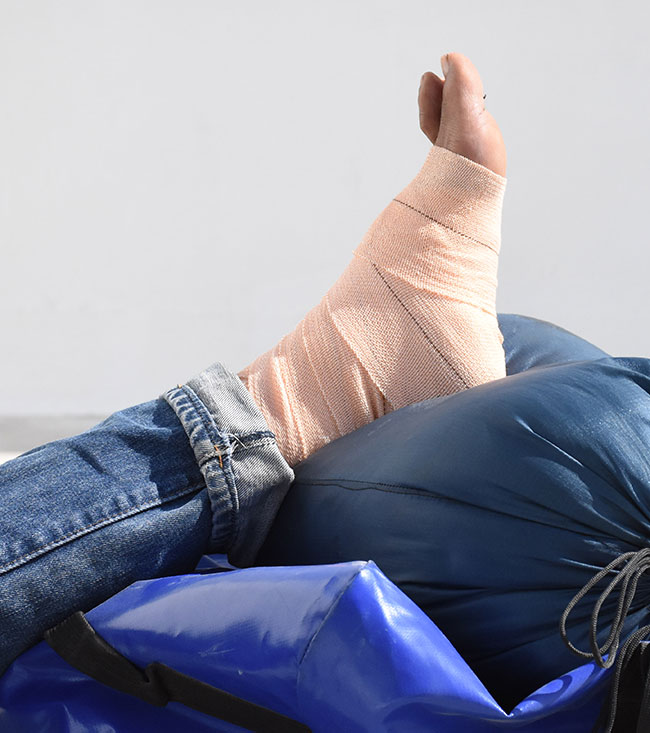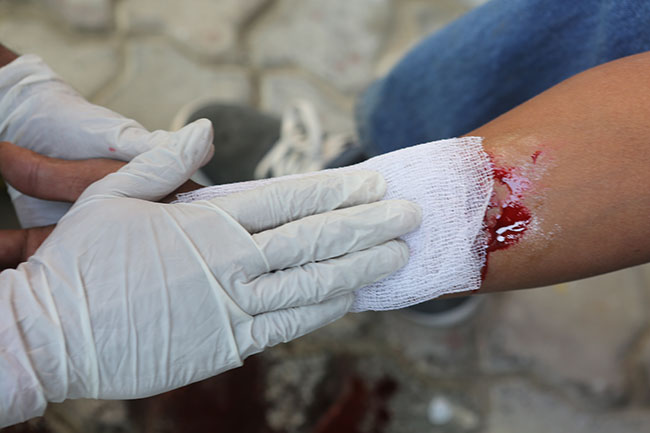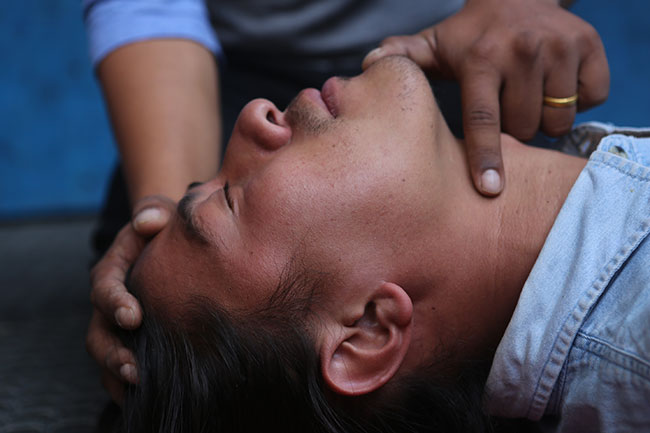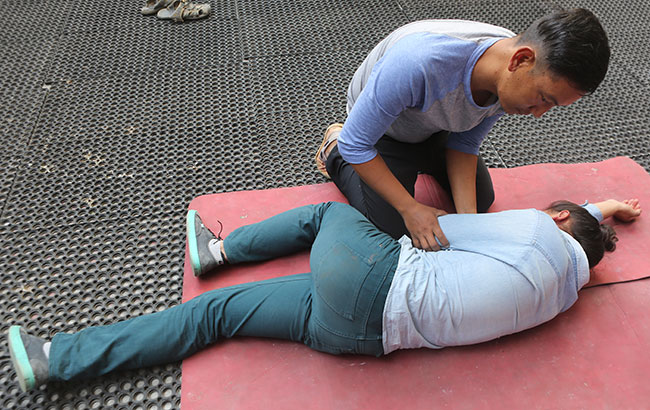Accidents are not something people invite, they are unavoidable. They can result in various levels of injuries and if not looked after correctly, can be fatal for the victim. In case of an accident rather than being a bystander, if one knows how to deal with the injury/illness, they can save lives.
First aid is one of the most important and basic life skills that one should learn. Quick medical attention might not be available when required, but with correct first-aid treatment it is possible to minimize health hazards and fatalities.
Nasana Bajracharya of My City talked to Wilderness First Responder and Executive Director at Himalayan Medics Rajesh Lama, and discussed a few situations where first-aid can be applied as well as the correct way to do it. Listed below is an excerpt of what he shared.

Muscle strain/sprain/bruise
Overstretching muscle tissue resulting in tearing and bruising is called sprains and strains. While tending to this, first check how much you can move the limb and if you can feel the sensation. Then, put the strained limb in rest to limit its movement. Use ice or water to cool the strained/swollen muscle and use bandage or cloth to wrap your limb and compress it. Check circulation, sensation and motion before you apply bandage. You can pour water or put ice pack over the cloth to further relax the muscle. Then elevate the muscle so that it is at a higher level than your heart and take rest. You can follow the same process for any bruised area with softer padding.

Wound management
There are two types of bleeding; open and closed. In case of an open bleeding, put direct pressure on the wound with a clean cloth or gauge pad and elevate it. Make sure you wear gloves. If the bleeding is heavy, put (multiple) gauze pad over the wound with enough pressure to first stop the bleeding. Once the bleeding stops, remove the pads slowly. Irrigate, especially the last one that’s attached to the wound, if needed.
52% of country's foreign aid went to province 3

Wound needs to be cleaned and dried for it to heal. Use gauge dabbed in diluted Dettol or Betadine solution to disinfect the wound. (If the solution is not available clean only with drinkable water). With slight pressure, move gauge in to out of wound to clean dirt/debris. Many tend to use the solution directly from bottle and rub over the wound, which causes tissue damage and slows the healing process. Seek medical attention (i) if the cut/wound is deeper than two centimeters, get it stitched and (ii) from old/rusty pieces of metal.
In case of internal bleeding, pad the area with the thick padding (cushion) and bandage it.
Burns
Put the affected area in cool water and clean the wound. Apply thin bandage (gauge) over the area. Do not keep the affected area open as body tends to lose the heat faster and the area becomes vulnerable to infection. You might or might not see blisters, if you do, do not pop them it will result in pain and infection. Seek medical help if the burn is large or deep, involves the face, neck, genitals, hands or foot.
But above all, the very first thing you need to do when encountering an injury or illness is to stay calm and not panic. In chaotic situations, panicking will result in more casualties and damages so assessing the situation around you before reacting is very important. Also in grave situations, do not let your emotional attachments get over your rationality and only do what you can.
Choking/airway obstruction
 Choking is a result of a condition where a foreign object (in most cases food) gets in the trachea (windpipe) and affects normal breathing process. The condition can be partial or full depending on size and angle of obstruction. Most people tend to hit the back of the one choking intending to make breathing easier but that is not the correct way.
Choking is a result of a condition where a foreign object (in most cases food) gets in the trachea (windpipe) and affects normal breathing process. The condition can be partial or full depending on size and angle of obstruction. Most people tend to hit the back of the one choking intending to make breathing easier but that is not the correct way.
First, encourage the injured to lean forward and cough. If the object does not come out perform Heimlich Maneuver. For this, stand behind the victim, put a fist on their belly button and roll it up where it almost touches the rib with another hand over it. Thrust inward until the food is out and they can breathe properly. If they faint, perform cardiopulmonary resuscitation (CPR), but only if you are trained.
If you are alone and start feeling choked, start coughing as hard as you can. Get up and find a chair. Take support and start thrusting your abdomen to the chair’s edge until you can start breathing properly. While treating infant, look in airway for object and remove it. If object is not identifiable, lay them over your knee with their face down. With your palm rub their back in a swift upward motion, starting from bottom of the back to their neck. Give five back blow, place them face up and look for the object again. If seen, remove. If not, perform five chest compression (CPR) and repeat.
Unconsciousness/ fainting
 If you find or see someone faint, follow the CAB (Circulation-Airway-Breathing) rule. Check their pulse first followed by airway and breathing. The normal respiratory rate for adult is 10–20 per minute whereas heart rate is 50–100 per minute. Reposition their head by tilting chin up if airway is compromised. Place them in a recovery position (sideways). Ask for help if needed and see if patient tends to vomit.If they fainted because of heat stroke, change the environment. Search for hints of medical history (sugar patients usually carry chocolates/insulin for emergency) and tend to it or call for proper medical help.
If you find or see someone faint, follow the CAB (Circulation-Airway-Breathing) rule. Check their pulse first followed by airway and breathing. The normal respiratory rate for adult is 10–20 per minute whereas heart rate is 50–100 per minute. Reposition their head by tilting chin up if airway is compromised. Place them in a recovery position (sideways). Ask for help if needed and see if patient tends to vomit.If they fainted because of heat stroke, change the environment. Search for hints of medical history (sugar patients usually carry chocolates/insulin for emergency) and tend to it or call for proper medical help.
Few First Aid Kit Essentials
1. Scissors
2. Tweezers
3. Irrigation Syringe(s)
4. Gauze (roll/pad)
5. Betadine/Dettol
6. Crepe Bandage and Sling/Swat (Triangular bandage)
7. Adhesive Tape (paper)/Band-aid
8. Thermometer
9. Oral Rehydration Solution (ORS)-Jeevanjal
10. Kidney Tray/Bowl
(If you have a known medical condition, you can also keep prescribed drugs in the kit for easy access)





































